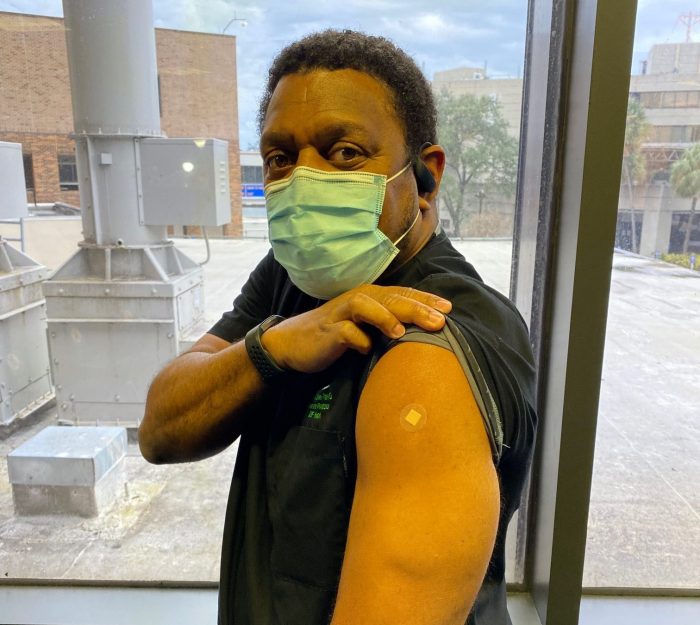For some of us, it seems so long ago, the arrival of this virus.
Now it’s literally what hangs in the air in my hours of waking, working, watching TV—then waking again, working again, and watching again. I see friends in masks or on screens. I eye strangers with suspicion when I need to go out, and I involuntarily take an extra step away when I hear a cough that’s not my own.
The ambiguity of the social situation obfuscates my sense of how to react or even be with others. Sometimes this is tied to fear, other times to simply wanting to do what seems right and not knowing what that is. It’s confusing and frustrating.
From the ancient Greeks, we have the story of Sisyphus, condemned for eternity to push a boulder up a giant hill, only to watch it roll back down just before he completes his ascent. When I first heard the story, I used to wonder what Sisyphus would do if he finally got the rock up there. After this past 11 months with the virus permeating the atmosphere while having to work, and while watching people, listening to people, and spending time away from people, I am pretty sure Sisyphus would just push it off, watch it roll back down, and start again.
This all came in a flurry, a blur, like a bad accident, seemingly from nowhere. Like a wayward relative, it settled in, emptying the refrigerator and liquor cabinet, lounging around complaining that he just can’t get a break while not going anywhere. Because it’s family, his being enabled—we’re slow to catch on that he has no intention of going anywhere. This is just one of many stops. He’s here, as long as tolerated.
In the Tao Te Ching, Lao Tzu writes, “The path into the light seems dark, the path forward seems to go back, the direct path seems long…” Ambiguous times have been around for thousands of years, and we are having ours.
“It’s just a flu, a cold thing,” talking media heads said. Physicians and scientists said something else: “It is a cold, but more contagious,” and, “It’s like a flu, but more virulent and more likely to cause death in people with pre-existing conditions.” And so we enabled it. We’ve all had colds and flus, and as long as we or anyone we care about doesn’t get it, why care? We have things to do and stuff to buy.
No one told us it was going to challenge our daily lives, not just with poor health, but with separations, closings, and having to starkly confront issues like some people not having food and our need for toilet paper at the same time.
A virus, according to biology, is not a living thing. It simply attaches to living cells, breaks them open, breaks itself open, and mixes DNA from its little virus capsule into the cell to set off a chain reaction that kills the cell and creates more of the virus. Like movie zombies in search of brains to eat, a virus attacks with reckless abandon. No planning, no sleeping, no stopping, just replication.
Sometimes our bodies will combat these zombies effectively, and sometimes they won’t. That is the way it has been for as long as we know. There is no love, no hate, no anger, no fear. There is simply float, attach, rupture, mix, explode, recreate, and float again. Those are the days and weeks of the virus.
A virus has nothing to do with freedom. It has no mind. No sense of time. No life or death. It solely follows its cycle. It doesn’t care if a host lives, dies, has debts, or carries a huge credit line. It has nothing to do with the world of understanding, of caring.
Break the cycle and the virus stops. It doesn’t go away. There have been ancient viruses found in ice cores, thousands of years old, that would begin a cycle again if time had not allowed bodies to adapt and create defenses long ago; or if their hosts had not become extinct.
We were all going about our business when COVID-19 knocked. We were busy getting our focus on, finding our flow, discovering our bliss, or just looking for our next dollar. Apart from virologists, few were concerned about some distant illness.
But it didn’t really come from nowhere. Although not alive, it mutates—it adapts, like life adapts. And it is a mutation of a cold virus. Most of us thought of this as our old pesky cold, and not some sort of super cold. It was hard to accept that a little whiskey and rest aren’t the medicine for this one.
I recently had the opportunity to see a presentation and spend time with the University of South Florida’s Dean of the Taneja College of Pharmacy, Dr. Sneed, and learn about COVID-19 and the vaccines that are beginning to arrive as of this writing.
A virus doesn’t have consciousness, is unaffected by opinions, and very likely, doesn’t recognize chi or “life force,” as it isn’t nor has it ever been, alive. Float, attach, rupture, mix, explode, and float again; that’s all there is.
Our bodies defend against it by first recognizing it is there. Although COVID, in general, has been around a long time, this version, 19, is new. A mutation. Initially, it tends to drift its way around within us uninhibited, the more virulent strain attaching to any number of organs, populating our bodies past our bodies’ capacity to catch up and defend. That’s why, initially, our best defense is not to catch it in the first place.
It is hard to have compassion, or what Buddhists refer to as maitri, for those among us who won’t do the simple courtesy of wearing a mask to stave off the intrusion of destructive foreign particles into our bodies. It seems like—if they don’t care, why should I care about them? But they were or are someone’s child and maybe a parent. Maybe they are just having a bad day. I don’t know the story behind their behavior. I just don’t like the behavior, and I do know behavior can change.
Maitri is the Sanskrit word associated with the Buddha Maitreya, a future Buddha of wisdom and compassion. Some scholars have drawn parallels between Maitreya and the Roman god, Mithras. Mithras was believed to have arisen from a rock around the winter solstice, and his followers are the people who made handshakes popular. Some scholars also believe that the following of Mithras appears to be a derivation of the Persian worship of Mithra, brought to Rome by soldiers returning from battles with the Persian empire. Mithra was a Zoroastrian deity associated with the sun, justice, and contracts. Still further in history, it is likely that Mithra is a derivation of the Hittite deity, Mitra. Mitra was the keeper of pacts.
Caring and our relationships, as well as the byproduct of our relationships, social contracts, has been a fundamental building block for human civilization for a long time. We find ways to get along. And deity or no deity, ultimately it is up to us as individuals to find our way to live and work with others. We have to find it within ourselves. The clearest path for this is maitri.
We need each other, and whether or not we want to believe it, we simply don’t exist outside of our relationships with others. I am here because of my parents, just like everyone else. We are never “born alone.” Guaranteed that at a minimum, a mother was there. The things I wear, the tasks I do, the house I live in, the car I drive, and the words I write all came about because someone created and shared them. Our love for others is what keeps us successful and creative, and it is love that gets us through strange and fearful places, and through ambiguous decisions.
The strength of many makes us one. To wear masks, wash hands, and to distance are not about freedom. The virus doesn’t care about freedom; it doesn’t know anything about freedom—in fact, it doesn’t know anything. It doesn’t even know you, its host. It simply replicates.
Anyone reading or watching news about the virus knows of its weird shape with little grabby hooks. Listening to Dr. Sneed, I learned it’s those little grabby hooks that attach to any number of organs in our bodies, not just our lungs, and allow the virus to do its work. When we have immunity, our bodies create blocks to cover the hooks.
No hooks—no attaching, no attaching—no penetrating, no penetrating—no mixing, no new explosion of virus in our bodies. The cycle stops.
I also learned that although in their current state, the vaccines are new, but their development began back in 2013 to combat SARS. Later, these vaccines were refined to combat MERS. Both of these viruses are COVID viruses and both are deadly. The vaccines we are seeing today are not “new” new; they are better described as an evolution of years of work fighting versions of the COVID virus. The vaccine helps our bodies to recognize the virus and develop blockers for its regenerative process, effectively stopping it from going about its zombie work.
He also explained why a vaccine is a better option than letting my own body try to develop antibodies. Simply, to create my own antibodies, I would need to catch the virus, a risky option as it is not clear how my body will respond. Secondly, if I were to catch the virus and muddle through it, it is unclear how much immunity my body will develop. More and more frequently, there are cases of people catching COVID-19 more than once. A stable level of antibodies helps to make this less likely.
He went on also to speak about side effects, pointing out that at this stage, globally, across populations, there have been no fatalities with the vaccine, and most commonly, there have been general side effects like pain at the injection site and brief lethargy being reported.
It hasn’t been tested in populations that are at great risk, such as pregnant women and people with fragile medical conditions—in part to ensure that other medical complications aren’t mixing with what may or may not be side effects. As they learn more, this information will come.
The biggest challenge, he and his colleagues see, is now making sure people get the correct information about these things in this age of social media rumors and opinions. Being science-based means these questions are being examined, tested, and argued about, re-examined, and then released.
He stated that he would take the vaccine right in front of us if he could. At that moment, I realized, I would too.
Maitri: compassion for self and others. I am tired of seeing people line up for food. I want to see the smiles on the faces of my friends, to be greeted with a friendly embrace, and to do so in return. I want to go out to dinner and have conversations over coffee or drinks. I want to travel again. Perhaps even one day, I would like to dance to a live performance like a fool in a crowd, the notes and rhythm, without ambiguity, connecting to our hearts, speaking to us without words, telling us we can find joy in this world.
This can happen if we work together.


 Share on bsky
Share on bsky





Read 24 comments and reply